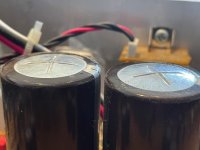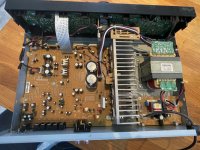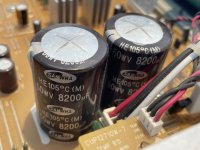Hey, first time here. Hope it's ok to post.
I have an Onkyo A-9010 2 channel HiFi amp that won't power up correctly. It clicks, the lights flash and then it powers off after about 1 second.
The Onkyo A-9010 is the UK version of the A-9000, but with uprated caps minus the DAC circuit.
It looks to me as if the two caps are in need of replacements, as they are slightly bulging. It doesn't look as though they have fully gone yet though. I can see any leakage from the bottom and the tops are only slightly domed. Would this power-on behaviour be consistent with duff caps?
Although I haven't yet found a source for these particular caps, I'm happy to replace them, but I'm not totally convinced they are the underlaying cause.
Any thoughts or wisdom appreciated. I used to be system installer in the pro-audio world, so am confident enough with a soldering iron to change out the caps, but only have limited experience with board level fault diagnosis, hence my post.
Many thanks indeed!
I have an Onkyo A-9010 2 channel HiFi amp that won't power up correctly. It clicks, the lights flash and then it powers off after about 1 second.
The Onkyo A-9010 is the UK version of the A-9000, but with uprated caps minus the DAC circuit.
It looks to me as if the two caps are in need of replacements, as they are slightly bulging. It doesn't look as though they have fully gone yet though. I can see any leakage from the bottom and the tops are only slightly domed. Would this power-on behaviour be consistent with duff caps?
Although I haven't yet found a source for these particular caps, I'm happy to replace them, but I'm not totally convinced they are the underlaying cause.
Any thoughts or wisdom appreciated. I used to be system installer in the pro-audio world, so am confident enough with a soldering iron to change out the caps, but only have limited experience with board level fault diagnosis, hence my post.
Many thanks indeed!
Attachments
To correctly check the power supply you should use multimeter on voltage AC meter range. I doubt that the caps are failed. They are working on 50Hz so there is little chance they failed.
Ripple voltage should be around 5% of your dc voltage, not more without load. With load ripple voltage will rise to about 10-20% of your dc voltage. It will be hard to see that because music is not constant and your multimeter is not real time equipment...
Check dc voltages and after that do your conclusion. It is not easy to repair electronic devices without good background or lot of experience.
Ripple voltage should be around 5% of your dc voltage, not more without load. With load ripple voltage will rise to about 10-20% of your dc voltage. It will be hard to see that because music is not constant and your multimeter is not real time equipment...
Check dc voltages and after that do your conclusion. It is not easy to repair electronic devices without good background or lot of experience.
The caps are looking like typical Samwha-garbage after some years of operation... But I doubt they are the cause of the amps behavior. First to be safe take a look if both rails are there. They should be something between (-)40 and (-)60V. Look for DC offset before the relay. You could measure at the center pin of the emitter resistors. Posts results here.
It's most likely the protection circuit kicking in. So you have an amp fault.
Can also be that the small lytics in the protection circuit have dried out. Unless clear DC can be measured on the power transistors' output (before relay) I would replace these as a measure of "hygiene".


